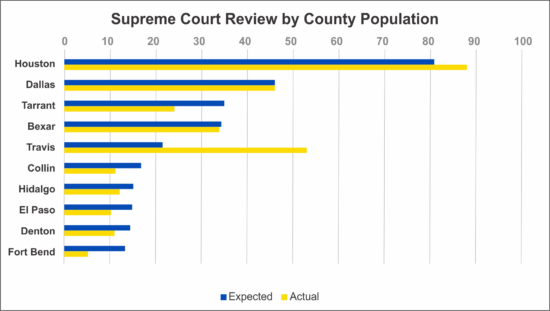Two years ago, I noted that the data shows that the Texas Supreme Court grants a disproportionate number of petitions for review that come through certain intermediate appellate courts. One of those intermediate appellate courts is the Third Court of Appeals District, informally known as the Austin Court of Appeals. That trend continues.
Focusing on granted petitions for review, I was curious about where some of these disputes started out, so I looked at what counties the cases originated in. All things being equal, I would expect to see more cases coming from counties with higher populations, which also have a higher number of trial courts. My assumption proved to be generally true.
Petitions for review granted for the 10 most populous counties
Isolating the ten most populous counties in Texas, I looked at the number of petitions actually granted that originated in each county versus the number that one might expect to come from that county if the grant rate was in proportion to the population. This is what the data looks like in graph form:
The Texas Supreme Court grants a higher-than-expected number of petitions for cases originating in Harris County and Travis County. Dallas County and Bexar County are about what would be expected. The other counties fall below what might be expected. I also note that though Jefferson County is not one of the state’s top 10 most populous counties, the number of petitions that were granted where the case originated in Jefferson County far exceeds what would be expected based upon population.
Grant rate for Travis County cases is high
The most interesting thing, in my view, about the graph is the grant rate for cases that originate in Travis County. At the county level, the discrepancy in expected grant rates for Travis County is more exaggerated than it is at the court of appeals level for the Austin Court of Appeals, where cases appealed from Travis County must go first.
The legislature establishes trial courts in counties according to the demands on the judicial system in a county. Population within a county is a big factor in placing demands on the judicial system. Travis County being the fifth most populous county in the state would be expected to have greater judicial needs than less populous counties. But Travis County is special in another way in that the legislature has required that certain types of cases involving the State of Texas and its political subdivisions must be filed in Travis County. This fact accounts for a higher number of cases starting out in Travis County than one might expect based upon the size of the county alone. And it is notable that 2/3 of the granted petitions for cases that originate in Travis County involve the state or one of its political subdivisions.
“Importance to the Jurisprudence of the State” is the gatekeeper
Ultimately, there is an “equalizer” that presumably creates a level playing field across all petitions for review regardless of what county the case started in or who the parties to the lawsuit may be. That equalizer is the Texas Supreme Court’s jurisdictional standard. That standard requires that a petition must “present a question of law that is important to the jurisprudence of the state.” Tex. Gov’t Code § 22.001(a). All of this leads to the question of why such a disproportionate number of cases from Travis County are deemed to raise a question of law that is important to the jurisprudence of the state. Do cases in which the state is a party or the state’s operations and business are at issue automatically qualify? I have my own thoughts about the answer to this question, but I decided to take an unscientific, informal poll of some of my fellow board-certified appellate lawyers to get their perspectives. I promised each of them anonymity in hopes of encouraging unfiltered responses.
There was near unanimity in the view that a petition does not present a question of law of importance to the jurisprudence of the state merely because the state or one of its subdivisions is a party or the issues involve state business. To paraphrase one respondent, the focus should be on the legal issues, not the parties. After all, the question is what is important to the jurisprudence, not what is important to the state.
But there was a healthy number of respondents that expressed the view that if the state or state’s business was involved, then there might be a greater likelihood that the petition was one that presented legal issues of importance to the state’s jurisprudence. And there was a mix of explanations as to why that might be the case.
Two respondents made the point that at the end of the day, it doesn’t matter what any of us think; all that matters is that the petition for review secured enough votes on the court to be granted. And perhaps this is the best explanation as to why petitions for review for cases originating in Travis County have such a high grant rate.

